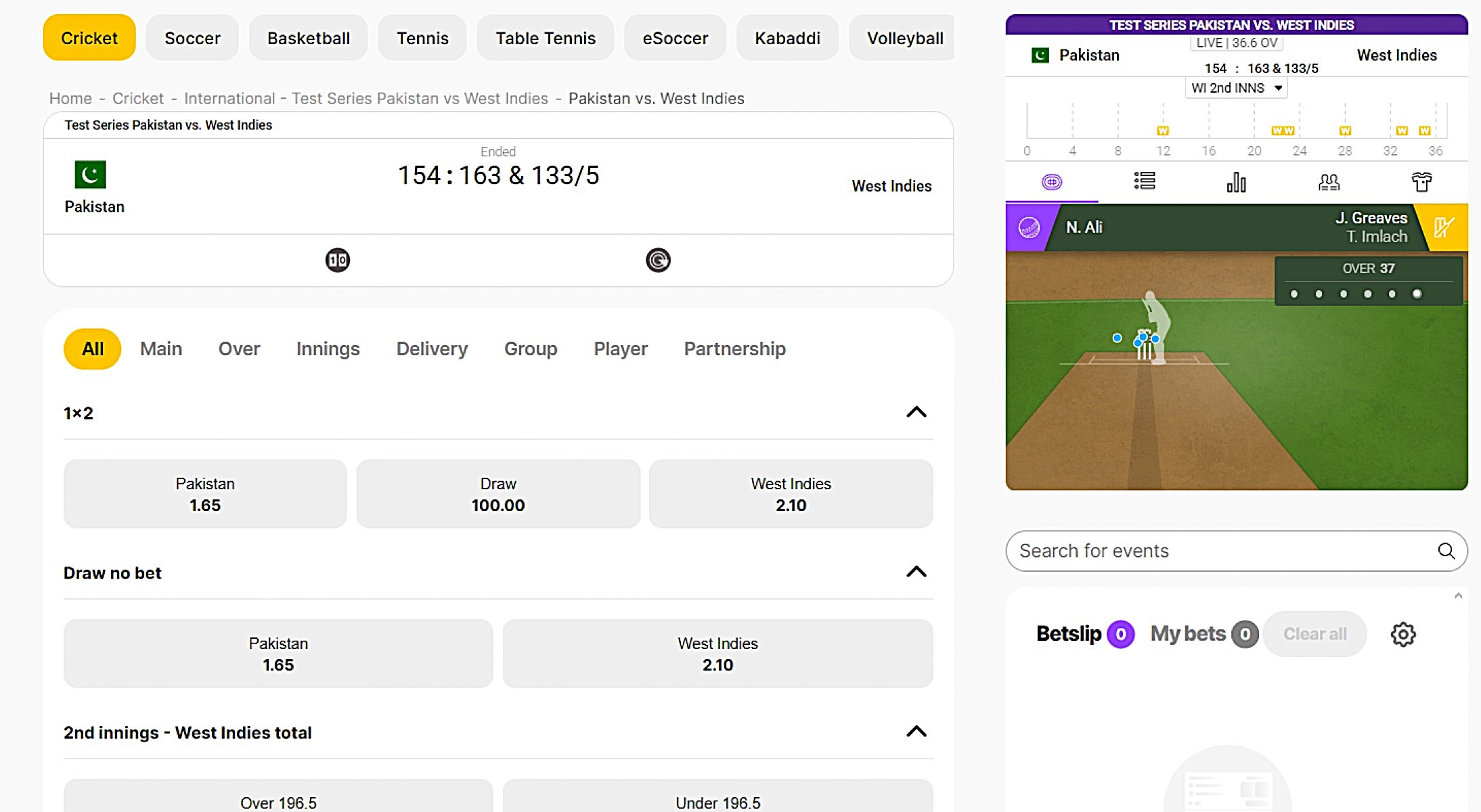Betting on sports has been a part of Indian culture for centuries, with various traditional sports gaining popularity in the region. But with the rise of modern sportsbooks and online platforms, betting on Indian sports has evolved into an industry of its own. But have you ever wondered how sportsbooks set betting lines for Indian sports? What factors do they consider, and how do they ensure they maintain a balance between offering competitive odds and protecting their own interests? Let’s break it down, step by step, to understand the process better.
Understanding Betting Lines: What Are They?
A betting line is the odds or prices that a sportsbook offers for a specific event. It’s the sportsbook’s way of predicting the potential outcome of a game, providing a structure for bettors to place wagers on different possibilities. Betting lines are designed to reflect the likelihood of certain outcomes and to generate action on both sides of the event. In essence, sportsbooks use betting lines to strike a balance between offering competitive odds to attract bettors while also ensuring they make a profit regardless of the event’s outcome.
These lines are a crucial aspect of sports betting, as they help bettors decide how much they want to wager based on the odds given for each outcome. The sportsbook creates these lines by analyzing various factors, including team performance, player statistics, and historical data. As betting lines evolve, they can shift to reflect new information or changes in the market. For example, if a star player is injured or a team performs poorly in recent matches, the betting line will adjust to reflect this new information.
In most cases, betting lines consist of a few key types, each offering a unique way to bet on an event. The most common is the moneyline, where bettors wager on which team or player will win the event outright. It’s a straightforward bet, with odds set based on the likelihood of each outcome. Another common type is the point spread, where sportsbooks adjust the odds to give the underdog a boost. This makes the bet more appealing by making it harder for the favorite to cover the spread. Lastly, there’s the over/under bet, also known as the total, where bettors wager on whether the combined score of both teams will be over or under a set number.
Sportsbooks adjust these lines based on several variables, including shifts in public perception, changes in team or player dynamics, and even weather conditions. They carefully monitor how much money is being wagered on each side, making adjustments as needed to maintain a balanced book and reduce risk. The process of setting and adjusting betting lines is an intricate blend of statistical analysis, market dynamics, and expert judgment.
The Role of Sportsbooks in Setting Lines for Indian Sports
Sportsbooks have a critical role in setting betting lines, as they need to ensure that the odds reflect the most accurate picture of the event.
- The recent form of teams and players, including their overall performance, win-loss ratios, and how they have performed in recent matches.
- Historical performance, such as past matchups between the teams, head-to-head statistics, and how teams have historically performed in specific conditions or tournaments.
- Weather conditions that can influence the game, such as rain, humidity, or temperature, which may impact the playing conditions, particularly in outdoor sports like cricket and football.
- Injuries or suspensions that could affect key players, which may shift the balance of the game and, consequently, the betting lines.
- Betting trends, including how much money has been wagered on particular outcomes and the public’s tendency to favor certain teams, which can prompt sportsbooks to adjust odds to maintain a balanced book.
- Home field advantage, as playing at home can provide a psychological boost for teams and influence the way odds are set.
- The impact of sponsorships or media deals on the popularity and public perception of teams, which can lead to shifts in betting patterns.
- The influence of high-profile events, such as major tournaments like the Indian Premier League (IPL), where sportsbooks adjust their lines to cater to large betting volumes and increased public interest.
Factors That Influence Betting Lines for Indian Sports
| Factor | Explanation | Impact on Betting Lines | Example in Indian Sports | Consideration for Sportsbooks |
| Team and Player Performance | This includes the current form of teams and individual players, focusing on their recent results, win-loss records, and key player stats. | Poor performance or outstanding form can lead to line adjustments. If a player or team is on a losing streak or a star is injured, it influences the odds. | In cricket, if a key bowler is injured, it impacts the team’s chances. | Sportsbooks adjust odds based on expected performance shifts due to player form or injuries. |
| Historical Data and Trends | Sportsbooks rely on past data to predict future outcomes. Historical trends, including past head-to-head performance and team consistency, are analyzed. | Past performances influence the initial odds, especially if certain teams have a strong record under specific conditions. | India’s cricket team may have a strong record in subcontinental conditions. | Using databases, sportsbooks adjust lines to reflect historical trends, balancing them with current team strength. |
| Weather Conditions | Weather, particularly in outdoor sports, can greatly affect performance. Humidity, temperature, and rain can all impact the game’s dynamics. | Poor weather can lower or raise a team’s chances. Sportsbooks will adjust lines to account for the impact of weather conditions. | Cricket matches are heavily influenced by the pitch and weather conditions. | Adjusting the lines for teams that may perform better under specific weather conditions. |
| Betting Market Analysis | Sportsbooks monitor betting activity to gauge public interest and balance bets. If one side is heavily bet on, the sportsbook will shift the odds. | Heavy betting on one side could lead to shifts in the odds to encourage betting on the other side to balance the book. | If many bettors place money on India to win, the sportsbook may adjust the odds. | Adjusting odds ensures the sportsbook minimizes its exposure and maintains balance. |
| Home Field Advantage | Playing at home often gives teams an advantage due to familiarity with the venue, local fan support, and reduced travel fatigue. | The home team is often favored in odds, but sportsbooks must carefully gauge whether this advantage is significant for the specific event. | Cricket matches in India see local teams often performing better due to crowd support. | Home advantage is factored into odds, but sportsbooks need to evaluate its true impact on each match. |
| Public Perception and Popularity | Public sentiment, especially surrounding star players or popular teams, can influence betting behavior. Strong fan bases lead to adjusted lines. | Popularity of a player or team can cause odds to shift, reflecting the betting market’s tendency to favor high-profile teams. | Shubman Gill’s rise in cricket might cause bettors to favor India in a match. | Public perception can skew betting activity, so sportsbooks adjust odds to ensure balanced betting. |
| Sponsorships and Partnerships | Corporate sponsorships and media coverage play a role in shaping the odds, as sportsbooks aim to provide attractive opportunities for sponsors. | Major sponsors may pressure sportsbooks to adjust odds to reflect their interests and to create betting options that attract attention. | IPL sponsorship deals influence the betting lines for team matches. | Sportsbooks balance the influence of sponsors by offering competitive odds that appeal to both sponsors and bettors. |
How Oddsmakers Use Algorithms to Set Betting Lines
In the digital age, oddsmakers rely on sophisticated algorithms and statistical models to set betting lines. These advanced tools are designed to process vast amounts of data in real-time, allowing sportsbooks to set accurate and dynamic odds that reflect current conditions. The use of algorithms has revolutionized the way sportsbooks operate, providing them with the ability to react swiftly to changes in data and betting trends. By doing so, they ensure that the odds remain competitive, and they can attract wagers from both sides of the event.
Algorithms take into account various factors when determining betting lines. One key element is the recent form of the players and teams. Oddsmakers analyze how well the teams or players have been performing lately, factoring in win-loss ratios, key victories, and any streaks that might impact the upcoming game. This real-time data helps ensure the odds are reflective of the most current team dynamics and individual performances.
Another important aspect considered by algorithms is player statistics, which vary depending on the sport. For example, in cricket, an algorithm might analyze a batsman’s average runs per match or a bowler’s strike rate. In football, it could look at the number of goals scored, assists, or even defensive metrics. These player-specific statistics are essential for determining the odds, as individual performances can heavily influence the outcome of a game.
Team dynamics also play a crucial role in setting betting lines. Algorithms consider how well teams perform against specific opponents based on historical data, such as head-to-head results, and other team-related variables, including team chemistry and injury reports. These models also factor in weather forecasts because weather conditions can dramatically alter how a game is played, especially in outdoor sports like cricket and football. Finally, algorithms take into account historical betting trends—past betting patterns can reveal how bettors have historically reacted to certain teams or players, helping sportsbooks fine-tune their lines to meet the market demand.
Setting Lines for Popular Indian Sports: Cricket, Football, Kabaddi, and More
- Cricket: Cricket is India’s most beloved sport, and setting lines for cricket involves analyzing the performance of teams and individual players. Sportsbooks look at recent matchups, player statistics such as batting and bowling averages, and the current form of the players. Pitch conditions and weather forecasts also play a significant role. For example, some pitches may favor fast bowlers or spinners, and weather conditions like humidity or rain could alter the game. The presence of star players, especially in the IPL, influences betting lines. Team dynamics and head-to-head records also factor into the line-setting process, as well as public betting trends driven by the popularity of teams or players.
- Football: Football is another major sport in India, and sportsbooks consider several key aspects when setting football lines. These include recent performance, player statistics (goals scored, assists, defensive metrics), and team dynamics. Injuries and player availability are particularly important, as the absence of a key player can dramatically affect the odds. Home field advantage is another factor, as teams typically perform better in familiar environments with the support of local fans. Head-to-head records and past performances also influence how odds are set, and betting trends may adjust the lines to account for public interest in certain teams or matches.
How Sportsbooks Adjust Lines During Live Events
| Sport | Trigger for Line Adjustment | Reason for Adjustment | Type of Line Adjustment | Impact on Betting Behavior |
| Cricket | Star player gets out early or key injury during a match. | Loss of a key player drastically affects team chances, leading to new dynamics. | Odds on the opposing team improve, while odds for the remaining team become less favorable. | Bettors may shift focus to betting on the new favorite, with changes in strategies. |
| Football | Team concedes an early goal or key injury during the game. | An early goal can significantly alter the team’s strategy, prompting a shift in momentum. | Odds shift to reflect the stronger team’s chances, and live betting lines are recalculated. | Bettors may look to place bets on the leading team or on a comeback for the trailing team. |
| Kabaddi | A key player is sent off or injured during the match. | Injuries or fouls that result in player loss can disrupt team strategy. | Odds on the injured team’s chances worsen, while the other team’s odds improve. | Bettors may place bets on the team gaining an advantage due to the player loss. |
| Field Hockey | A team scores an early goal or key player gets a yellow/red card. | A goal can quickly change the dynamics of a match, while red cards impact team performance. | The odds shift to reflect the team with the advantage, or a power-play scenario. | Bettors may change their bets depending on the game’s new power dynamics. |
| Badminton | Player suffers an injury or loses momentum in a set. | Injuries or sudden changes in form affect an individual player’s chances. | Odds adjust to reflect the player’s reduced chances of winning or a comeback by the opponent. | Bettors may take advantage of the shift in odds by betting on the player now favored. |
Sportsbook Strategies to Minimize Risk
Sportsbooks face significant risk when setting betting lines, especially in high-stakes markets like Indian sports, where the outcomes can be unpredictable. To minimize this risk and ensure they remain profitable, sportsbooks employ a variety of strategies. These strategies are designed to balance the betting action, attract a wide range of bettors, and manage the risk associated with each wager. Let’s explore some of the key methods sportsbooks use to minimize their risk.
One of the most common strategies is line movement. This involves sportsbooks continuously adjusting the odds as the event unfolds or as betting patterns change. The goal is to keep the betting action balanced on both sides of a wager, so sportsbooks don’t become overly exposed to one outcome. For example, if too many bettors are placing wagers on one team to win, the sportsbook will shift the odds to make the other team more appealing. By doing this, sportsbooks can attract more bets on the underdog, balancing the risk. This constant adjustment ensures that no matter what happens during the event, the sportsbook can make a profit.
Another method used to minimize risk is arbitrage betting. In this strategy, sportsbooks use sophisticated algorithms to identify situations where they can offer different odds across multiple platforms, guaranteeing a profit no matter the outcome of the event. These arbitrage opportunities arise when there are discrepancies in betting lines across various sportsbooks. If a sportsbook identifies a situation where it can offer odds that would result in a guaranteed win for the bettor, it will adjust the lines to protect itself. While this is a more advanced strategy, it helps sportsbooks manage their overall risk exposure, especially when dealing with high volumes of betting action.




